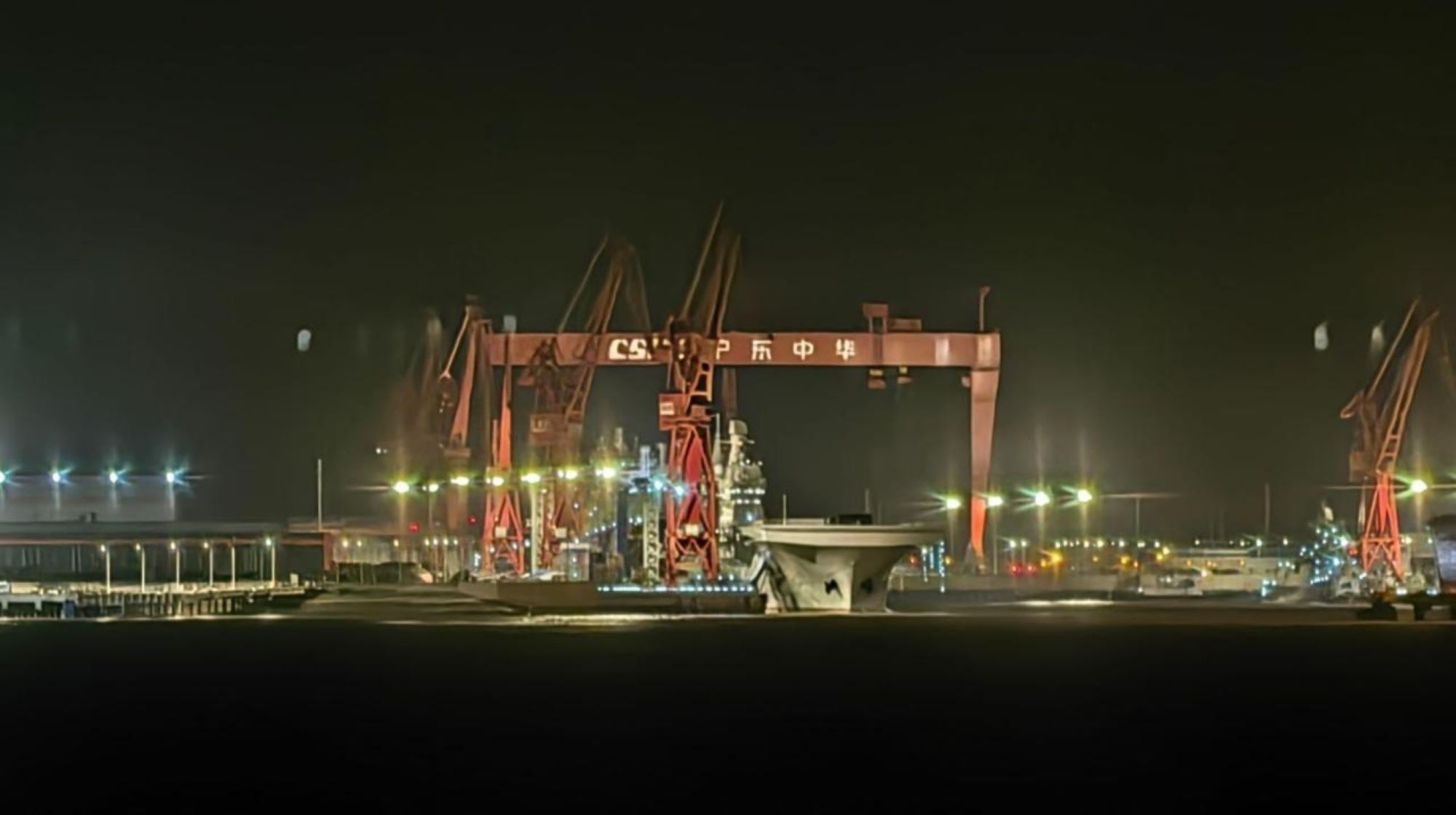The Sichuan is the only landing dock for amphibious assault helicopters in the world that features an electromagnetic catapult and arresting cables intended for fixed-wing aircraft.
The catapult aboard China’s massive Type 076 LHD (Landing Helicopter Dock) amphibious assault ship, the “Sichuan”, has been tested for the first time, according to images that appeared in October 22, 2025. The LHD, with a displacement of 40,000 tonnes, was confirmed to have a single catapult on the port side of its main flight deck when an aerial satellite image of the ship under construction in June 9, 2024 showed a long empty section that observers concluded would house the catapult.
Later official images of her commissioning on 27 December 2024 showed the long shed covering the port side of the deck, running longitudinally, again confirming the presence of the catapult. These sheds were also previously used for cover the CNS Fujian catapults.
That aircraft carrier, which reached a major milestone in September by launching and recovering the J-35 stealth fighter, J-15T aircraft and KJ-600 AEW&C aircraft, also underwent a similar test of its EMALS (Electromagnetic Launch System) catapult in November 26, 2023.
076型強襲揚陸艦1番艦”四川(51)”がダミーウェイトを用いた電磁カタパルトの射出試験を実施したとみられるとのこと.
進水から1年足らずではあるが近いうちに海上公試を開始する見込み. https://t.co/UZBrJ9vWu7 pic.twitter.com/S76mzGEahn— お砂糖wsnbn (@sugar_wsnbn) October 22, 2025
The Sichuan is the only amphibious ship in the world to have a catapult launch system, and previous satellite images At simulated test sites they have indicated that it would carry the GJ-11 Sharp Sword UCAV. That flying-wing aircraft paraded, along with at least four different types of CCA/UCAV, in September.
The ship also features a twin-island layout, similar to the Royal Navy’s HMS Queen Elizabeth-class aircraft carriers.
Catapult tests
The unofficial image of the Fujian test showed a splash in the harbor water, ahead of the bow of the aircraft carrier, indicating the impact of the representative test object, usually a sled, launched from the EMALS catapult.
Even without official confirmation, we can safely conclude that the Sichuan has an EMALS-powered catapult, and not a steam one, as China already has a functional and homegrown technology in the Fujian. It is very possible that the Sichuan EMALS is a derivative of the flattop.
⚡ 🇨🇳 China’s Type 076 Sichuan tests EMALS catapult for drone launches.
PLAN’s new amphibious assault ship Sichuan has just concluded its first electromagnetic catapult tests during maritime trials in the East China Sea. This configuration allows you to launch fixed-wing drones and helicopters into action,… pic.twitter.com/92J3TWLalF
— G-2 status report (@G2_SITREP) October 22, 2025
In the image of the Sichuan that supposedly represents the catapult test, the ship is turned and with its back to the dock where it is docked parallel. This could be done to move away from other smaller vessels and tugs. We don’t see a test object on deck or a splash in the water to definitively capture the evidence.
However, evidence of the EMALS catapult test, along with the nighttime image of the Sichuan with its back to the dock, was a warning to sailors by the Shanghai Maritime Safety Administration. “[It designated] a small rectangular no-entry zone from October 20 to 29, directly in front of the shipyard dock entrance,” said the SCMP (South China Morning Post).
The notice to boaters cited daily “underwater activities” within the zone from 9 a.m. to 5 p.m. Since such tests typically use sleds as test objects, “underwater activities” may refer to the recovery of the test vehicle. Furthermore, considering the speed at which the ship has progressed, we can assume that it would begin port acceptance trials later this year and sea trials at least before mid-2026.
On November 26, the Type 003 aircraft carrier “Fujian” (PLANS-18) conducted an electromagnetic catapult ejection test which was said to be successful.
(Images and clip via @风Qing颂 from Weibo) pic.twitter.com/0sp7LToJCH
– @Rupprecht_A (@RupprechtDeino) November 26, 2023
On November 26, the Type 003 aircraft carrier “Fujian” (PLANS-18) conducted an electromagnetic catapult ejection test which was said to be successful.
(Images and clip via @风Qing颂 from Weibo) pic.twitter.com/0sp7LToJCH
– @Rupprecht_A (@RupprechtDeino) November 26, 2023
Role of the CNS in Sichuan
In addition to being the largest amphibious assault carrier that would be used in an invasion of Taiwan, alongside the Type 075, particularly for the rocky waters off its eastern coasts, another common consensus is that the new LHD would carry the GJ-11 flying-wing UCAV.
While the various civilian RoRo (Roll-On/Roll-Off) vessels frequently displayed in exercises could easily reach the western shores of Taiwan off the eastern coast of China, the rough seas to the east, deep in the western Pacific, can only be handled by warships such as the Type 075 and Type 076.
The helicopter fleet could consist of a combination of helicopters including the Changhe Z-8, Z-9, Z-18, Z-20, Z-10 attack helicopter or even the Z-21 heavy class attack helicopter. If used as a light aircraft carrier, it can carry the J-15T, J-15DT electronic warfare aircraft or J-35. However, that possibility seems remote, given that the width of the Type 076 Sichuan is evidently small for large fighters.
In satellite images of the Changxing Island shipbuilding base, what appear to be mock-ups of GJ-11 drones are seen at a testing facility. They are likely to be there in anticipation of testing of the Type 003 aircraft carrier and potentially the Type 076 once it is completed. pic.twitter.com/AV9SWqthHq
— CSIS (@CSIS) August 6, 2024
Role of the aircraft aboard CNS Sichuan
The presence of arresting cables, the EMALS catapult and the existence at aircraft carrier test sites of mock-ups of the GJ-11 certainly make it an interesting amphibious attack concept, the first of its kind. Meanwhile, Turkey’s TCG Anadolu, another ski jump amphibious attack ship, has hosted dozens of TB3 Bayraktar UCAV takeoffs and landings, but has no arrester cables or an EMALS catapult.

It remains to be seen how the GJ-11 could be used in this scheme of things. However, the most plausible explanation could be that the amphibious aircraft carrier might want its own organic unmanned ISR strike capability with a LO (Low-Observable) aircraft, without having to rely on the assets of the PLARF (PLA Rocket Force), the other three aircraft carriers of the PLA Navy.
An amphibious landing in front of fortified beachhead defenses and underground shelters (the latest stage in the escalation of the naval blockade aimed at putting pressure on Taiwan’s leaders, and which would be undertaken if they do not relent) would be a bloody affair, considering the Normandy landings.
The first Type 076, PLANS-51 “Sichuan”, has left the dock.
(Images via @央视军事 from Weibo) pic.twitter.com/ULb1EAvs4N
– @Rupprecht_A (@RupprechtDeino) December 29, 2024
The GJ-11, or any aircraft for which the arresting hooks and catapult are intended, would have a role in High-Altitude Long-Endurance (HALE) aerial surveillance. By observing beachheads and interior defenses, the aircraft could possibly “soften” some of them, before releasing tanks and amphibious troops.



